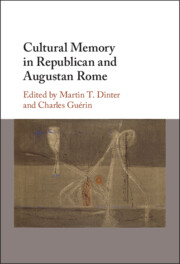Book contents
- Cultural Memory in Republican and Augustan Rome
- Cultural Memory in Republican and Augustan Rome
- Copyright page
- Contents
- Figures
- Contributors
- Acknowledgements
- Chapter 1 Introduction: What is Cultural Memory?
- Part I Writing Cultural Memory
- Part II Politicising Cultural Memory
- Chapter 10 Sulla’s Dictatorship Rei Publicae Constituendae and Roman Republican Cultural Memory
- Chapter 11 Remembering Differently: The Exemplarity ofPopulares as a Site of Ideological Contest in Late Republican Oratory
- Chapter 12 Cultural Memory and Political Change in the Public Speech of the Late Roman Republic
- Chapter 13 Remembering M. Brutus: From Mixed and Hostile Perspectives
- Chapter 14 The Making of an Exemplum: Cato’s Road to Uticensis in Roman Cultural Memory
- Part III Building Cultural Memory
- Part IV Locating Cultural Memory
- Bibliography
- Index Locorum
- Index
Chapter 14 - The Making of an Exemplum: Cato’s Road to Uticensis in Roman Cultural Memory
from Part II - Politicising Cultural Memory
Published online by Cambridge University Press: 27 April 2023
- Cultural Memory in Republican and Augustan Rome
- Cultural Memory in Republican and Augustan Rome
- Copyright page
- Contents
- Figures
- Contributors
- Acknowledgements
- Chapter 1 Introduction: What is Cultural Memory?
- Part I Writing Cultural Memory
- Part II Politicising Cultural Memory
- Chapter 10 Sulla’s Dictatorship Rei Publicae Constituendae and Roman Republican Cultural Memory
- Chapter 11 Remembering Differently: The Exemplarity ofPopulares as a Site of Ideological Contest in Late Republican Oratory
- Chapter 12 Cultural Memory and Political Change in the Public Speech of the Late Roman Republic
- Chapter 13 Remembering M. Brutus: From Mixed and Hostile Perspectives
- Chapter 14 The Making of an Exemplum: Cato’s Road to Uticensis in Roman Cultural Memory
- Part III Building Cultural Memory
- Part IV Locating Cultural Memory
- Bibliography
- Index Locorum
- Index
Summary
This is a tale of two Catos, the real-life man and the legend. The difference can be helpfully illuminated through two stories. Our first opens on 5 December 63 BC in Rome at the Temple of Concord where an important meeting of the Senate has been debating the fate of the Catilinarian conspirators.1 Should they face exile or death? Decimus Junius Silanus, the consul-elect for the following year, proposes execution and many others in the Senate agree. But Gaius Julius Caesar, the praetor-elect and new pontifex maximus, steps forth and makes a stirring speech against the death penalty, arguing instead for exile. The Senate is momentarily persuaded, but then something remarkable happens: Marcus Porcius Cato, only thirty-two years old and the tribune-elect, stands up and delivers a passionate, uncompromising speech against Caesar’s motion, articulating the need for decisive action to deter future treason. His speech sways his fellow senators back to a vote for execution of the conspirators. Everyone present takes note, for a new senatorial star is on the rise.
Keywords
- Type
- Chapter
- Information
- Cultural Memory in Republican and Augustan Rome , pp. 239 - 258Publisher: Cambridge University PressPrint publication year: 2023



